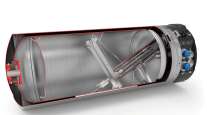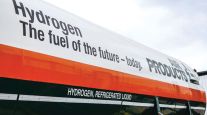Senior Reporter
NACFE Study Shows Flat Fuel Economy for Class 8 Vehicles Surveyed

[Stay on top of transportation news: Get TTNews in your inbox.]
The North American Council for Freight Efficiency said fuel efficiency in Class 8 trucks participating in its annual fleet study from 2018 to 2020 remained flat at 7.24 mpg after seven previous years of 2% annual increases.
The study had been on a three-year hiatus, in part because of the COVID-19 pandemic, and a new report was released Dec. 13.
NACFE Executive Director Mike Roeth said there are several probable reasons for the lack of an increase in fleet fuel economy the past three-plus years.
“There’s been a leveling off, but we see this as a short-term leveling off, because there is a lot more to gain here,” Roeth said. “We’ve not squeezed the last blood out of the turnip, as they say. We have a lot of fuel economy on diesel trucks still to harvest.”
Even as the miles-per-gallon figure remained unchanged, NACFE said the 15 fleets in the study, operating 75,000 trucks, saved $540 million in 2021 compared with the average trucks on the road.
New Benchmarking Tool Accompanies NACFE's 2022 Fleet Fuel Study - https://t.co/1HehRQ3QRc pic.twitter.com/Q9nLZjPqs6 — North American Council for Freight Efficiency (@NACFE_Freight) December 13, 2022
“Given the challenges that fleets and our entire industry had with the pandemic, NACFE decided to delay data acquisition and analysis,” Roeth said. “Given today’s high fuel prices, the study findings are particularly relevant and should help fleets make the right decisions on adopting technologies and practices that enhance freight efficiency.”
Roeth said among the reasons for the stagnant numbers is that many trucking companies are changing their routes, with more regional trips versus longer over-the-road routes. Regional trips often involve more city driving and more starts and stops, which Roeth said impacts fuel economy. He also noted that some linehaul companies that had participated in previous surveys were swapped out with regional carriers.
As a result of the COVID-19 pandemic, more drivers said they were idling longer and spending more time in their cabs, isolated to avoid becoming exposed to the virus.
Supply chain challenges and the increasing demand for new trucks means it has taken longer for new, more fuel-efficient trucks to get on the road. Roeth also noted that some fleets have increased the speed on their trucks, offsetting some of the fuel gains.
NACFE’s leadership said another key measure, the average miles per gallon of the nation’s fleet, increased from 5.98 in 2018 to 6.24 in 2021.
“This is a significant improvement and has helped the operators of the 1.7 million tractors operating in the U.S. reduce their fuel costs,” Roeth said.
As a result of the report, NACFE recommends that fleets follow a number of strategies, among them:
- Collect and monitor fuel economy by vehicle.
- Set long-term fuel economy targets and measure performance using the new benchmarking tool.
- Commit to an ongoing plan for fuel-economy improvement.
- Assign a test route and driver to try out new technologies.
- Purchase used equipment only from fleets known to have good fuel mileage and allow for failure, keeping in mind not all technologies will work in every application.
Even as the industry is making significant steps toward battery-electric and alternative-fueled vehicles, including hydrogen, Roeth noted the NACFE study indicates there are several steps fleets can take to reduce fuel consumption and tailpipe emissions using readily available technologies.
“Increasing fuel efficiency is a definite sustainability action taken by fleets today. They don’t have to wait to deploy zero-emission trucks to make a difference,” he said. “What we find far too often is that decarbonization is only thought of as zero-emission trucks. That’s wrong. Any time a fleet burns less fuel to ship the same amount of goods, they are decarbonizing.”
As fleets look to increase their fuel efficiency, even as the price of diesel begins to steadily decline, NACFE for the first time is providing an interactive benchmarking tool along with the report. The council said the online tool gives fleets the ability to enter information on their own adoption practices for the studied technologies to see how they compare with the fleets in the study.
Fleets that use the tool will receive a customized link to an interactive report that will include the user’s responses prioritized by the technologies that have the greatest gap between the user and the average of the fleets in the study.
“In addition, we believe many of these technologies and practices will transfer to alternative-fueled vehicles where they will help extend range,” said Yunsu Park, NACFE’s director of engineering and the study’s author.
Want more news? Listen to today's daily briefing below or go here for more info:




